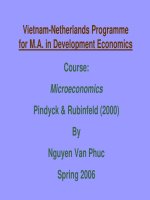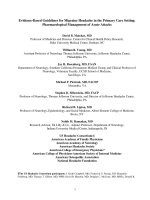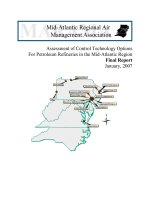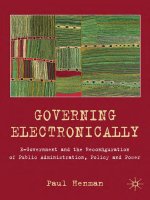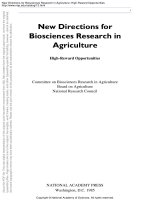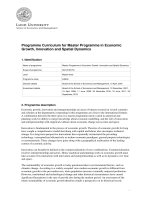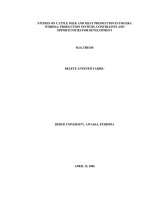Network Reconfiguration For Loss Reduction In Three-Phase Power Distribution Systems
Bạn đang xem bản rút gọn của tài liệu. Xem và tải ngay bản đầy đủ của tài liệu tại đây (456.4 KB, 71 trang )
NETWORK RECONFIGURATION FOR LOSS
REDUCTION IN THREE-PHASE POWER
DISTRIBUTION SYSTEMS
A Thesis
Presented to the Faculty of the Graduate School
of Cornell University
in Partial Fulfillment of the Requirements for the Degree of
Master of Science
by
Ray Daniel Zimmerman
May 1992
© Ray Daniel Zimmerman 1992
ALL RIGHTS RESERVED
ABSTRACT
Power distribution systems typically have tie and sectionalizing switches
whose states determine the topological configuration of the network. The
system configuration affects the efficiency with which the power supplied
by the substation is transferred to the load. Power companies are interested in finding the most efficient configuration, the one which minimizes
the real power loss of their three-phase distribution systems.
In this thesis the network reconfiguration problem is formulated as single
objective optimization problem with equality and inequality constraints.
The proposed solution to this problem is based on a general combinatorial
optimization algorithm known as simulated annealing. To ensure that a
solution is feasible it must satisfy Kirchhoff’s voltage and current laws,
which in a three-phase distribution system can be expressed as the threephase power flow equations. The derivation of these equations is presented
along with a summary of related three-phase system modeling.
The simulated annealing algorithm is described in a general context and
then applied specifically to the network reconfiguration problem. Also presented here is a description of the implementation of this solution algorithm in a C language program.
This program was tested on a Sun workstation, given an example system
with 147 buses and 12 switches. The algorithm converged to the optimal
solution in a matter of minutes demonstrating the feasibility of using sim-
ulated annealing to solve the problem of network reconfiguration for loss
reduction in a three-phase power distribution system. These results provide the basis for the extension of existing methods for single-phase or balanced systems to the more complex and increasingly more necessary threephase unbalanced case.
Biographical Sketch
Ray Daniel Zimmerman was born in Ephrata, PA on December 17, 1965.
Four years later he moved with his family to a chicken farm in rural Lancaster County, PA where he lived until he began studying Electrical Engineering in September of 1984. As an undergraduate at Drexel University
in Philadelphia, PA he participated in a cooperative education program
which involved working for six month periods at each of the following companies: IBM Corporation, Research Triangle Park, NC, Evaluation Associates, Bala Cynwyd, PA, and UNISYS Corporation, Tredyffrin, PA. In each
of these positions he did various computer hardware and software related
tasks. In 1986 he was awarded the EastmanKodak Company Scholarship. He received a
Bachelor of Science degree in Electrical Engineering from Drexel University in June 1989. In
August of the same year he began graduate
studies in Electrical Engineering at Cornell University in Ithaca, NY.
iii
to Esther
iv
Acknowledgments
O Lord my God, I will give you thanks forever. Psalm 30:12
I want to give my appreciation to my advisor, Dr. Hsiao-Dong Chiang, for
his invaluable help in getting me started on this project, his constant generosity in providing the necessary tools to do the work, and the many group
dinners (which served as motivation). I thank Dr. James Thorp for his role
on my Special Committee as well. I would like to acknowledge Dr.
Jianzhong Tong and the Paralogix Corporation for their respective contributions to the load flow program. My appreciation also goes to René JeanJumeau and Pauline Bennett for their encouragement and experience.
My deepest appreciation go to all of my family and friends who prayed for
me so faithfully during the time of the writing of this thesis. My parents
have been a constant and invaluable support to me throughout every stage
of my education and certainly no less during the writing of this thesis.
Thanks, Mom and Dad. Thanks also to Ernie for proofreading the final
draft and offering helpful stylistic comments. A very special thanks to
Esther for her love, prayers, and many letters without which I’m sure I
would have despaired. Muchísimas gracias. I’d also like to acknowledge my
housemates Karl Johnson, Tom Krauss, and Mark Lattery for their constant support and their great patience with me during the month that I
didn’t exist around the house. Special thanks go to Tom for his helpful comments on the first draft. Thanks also to my entire family at Covenant
Church, especially Ray and Gretchen Crognale, for their love and prayers.
v
Table of Contents
ABSTRACT
Biographical Sketch.....................................................................................................iii
Acknowledgments..........................................................................................................v
Table of Contents......................................................................................................... vi
List of Tables .............................................................................................................viii
List of Figures.............................................................................................................. ix
1
Introduction
1
2
Problem Formulation
4
2.1 Search Space...................................................................................................5
2.2 State Space......................................................................................................6
2.3 Cost Function..................................................................................................6
2.4 Constraints ......................................................................................................8
2.4.1 Topological Constraints......................................................................8
2.4.2 Electrical Constraints..........................................................................9
2.4.3 Operational Constraints ......................................................................9
2.4.4 Load Constraints...............................................................................10
3
Three-Phase Distribution Power Flow
11
3.1 Three-Phase vs. Single-Phase Power Flow...................................................12
3.2 Component Models.......................................................................................13
3.2.1 Conductor Model ..............................................................................13
3.2.2 Shunt Capacitor Model .....................................................................15
3.2.3 Cogenerator Model ...........................................................................15
3.2.4 Transformer Model...........................................................................16
3.2.5 Load Model.......................................................................................17
3.3 Three-Phase Power Flow Equations.............................................................17
3.4 Problem Formulation ....................................................................................19
3.5 Comments on Formulation and Solution Algorithms...................................21
4
Simulated Annealing
23
4.1 Combinatorial Optimization .........................................................................23
4.2 Analogy to Physical Annealing ....................................................................24
4.3 The Simulated Annealing Algorithm............................................................26
4.3.1 Acceptance Probability.....................................................................26
4.3.2 Asymptotic Convergence Characteristics.........................................28
4.3.3 Finite Time Approximations.............................................................29
4.4 Implementation .............................................................................................30
vi
5
Implementation of the Solution Algorithm
32
5.1 Search Space.................................................................................................33
5.2 Objective Function........................................................................................33
5.3 Perturbation Mechanism...............................................................................34
5.3.1 Topological Constraints....................................................................34
5.3.2 Electrical Constraints........................................................................37
5.3.3 Load and Operational Constraints ....................................................38
5.4 Cooling Schedule..........................................................................................38
5.4.1 Initial Temperature............................................................................39
5.4.2 Temperature Update..........................................................................39
5.4.3 Markov Chain Length.......................................................................40
5.4.4 Termination Criterion .......................................................................40
5.5 Comments on Implementation......................................................................40
6
Simulation Results
41
6.1 Example Test System....................................................................................41
6.2 Initial Configuration......................................................................................43
6.3 Final Configuration.......................................................................................43
6.4 Discussion of Convergence Behavior...........................................................45
7
Conclusions
52
7.1 What Was Accomplished..............................................................................52
7.2 What Remains to be Done ............................................................................53
7.2.1 Refining the Current Implementation...............................................53
7.2.2 Extending the Current Implementation.............................................55
Bibliography ................................................................................................................59
vii
List of Tables
Table 3.1
Iterative Power Flow Solution ................................................................22
Table 4.1
Table 4.2
Simulated vs. Physical Annealing...........................................................25
Elements of a Cooling Schedule.............................................................30
Table 5.1
Table 5.2
Implementing Simulated Annealing .......................................................32
Perturbation Mechanism.........................................................................35
Table 6.1
Summary of Results................................................................................45
viii
List of Figures
Figure 2.1 Typical Radial Distribution System..........................................................9
Figure 3.1
Figure 3.2
Figure 3.3
Figure 3.4
Three-Phase Conductor Model ...............................................................13
Compound π-equivalent Model for Three-Phase Conductor..................14
Three-Phase Shunt Capacitor Model ......................................................15
Three-Phase Transformer Model............................................................16
Figure 4.1 Acceptance Probability vs. Temperature & Change in Objective
Function ..................................................................................................27
Figure 4.2 The Algorithm (pseudo C code) .............................................................31
Figure 6.1
Figure 6.2
Figure 6.3
Figure 6.4
Figure 6.5
Figure 6.6
Figure 6.7
Figure 6.8
Example Test System: Initial Configuration...........................................42
Example Test System: Optimal Configuration.......................................44
System Voltage Profiles..........................................................................46
Temperature vs. Markov Chain Number ................................................47
Acceptance Ratio vs. Temperature .........................................................48
Objective Function Value vs. Temperature ............................................49
Objective Function Value vs. Accepted Moves......................................50
Objective Function Value vs. Iteration Number.....................................50
ix
Chapter 1
Introduction
In the past decade or so, with the advances in communication and data
processing technology, electric utility companies have become very interested in distribution automation. It is apparent that with the increasing
complexity of power distribution systems, it is becoming essential to automate some tasks that have always been done manually. It has also been
estimated that utilities could save as much as 10% of their annual maintenance and operating expenses by taking advantage of this technology [14].
One important area in which distribution automation is being applied is
the area of network reconfiguration. Network reconfiguration refers to the
closing and opening of switches in a power distribution system in order to
alter the network topology, and thus the flow of power from the substation
to the customers. There are two primary reasons to reconfigure a distribution network during normal operation. Depending on the current loading
conditions, reconfiguration may become necessary in order to eliminate
overloads on specific system components such as transformers or line sections. In this case it is known as load balancing. As the loading conditions
1
2
on the system change it may also become profitable to reconfigure in order
to reduce the real power losses in the network. This is usually referred to
as network reconfiguration for loss reduction and is the topic of this thesis.
Network reconfiguration in both of these cases can be classified as a minimal spanning tree problem, which is known to be an NP–complete combinatorial optimization problem. A method is needed to quickly find the
network configuration which minimizes the total real power loss of the network while satisfying all of the system constraints. Several approaches
have been applied to the solution of this problem with varying degrees of
success. Heuristic methods [3; 13; 20] have been used successfully to find
sub-optimal solutions rapidly. The genetic algorithm [19] and simulated
annealing [11; 12], which require much more computation time, have been
used to find optimal solutions. It seems that these methods have only been
applied to relatively small, balanced, or single-phase distribution systems.
Power utility companies currently need an algorithm which can be applied
to their large three-phase unbalanced distribution systems.
This thesis presents a method based on simulated annealing. In Chapter 2
the problem is formulated as single objective optimization problem with
equality and inequality constraints. The three-phase power flow problem,
one of the important elements in any network reconfiguration method, is
presented in a general formulation in Chapter 3 along with a brief discussion of solution techniques. Chapter 4 describes the simulated annealing
algorithm in a general context as a tool for solving combinatorial optimization problems. Chapter 5 gives a description of how simulated annealing
can be applied to the problem of network reconfiguration for loss reduction
3
in a three-phase distribution system. Based on the solution methodology
presented in Chapter 5, a program was written in C language implementing the algorithm for solving for the optimal network configuration. This
program was run on a 147 bus example system and the results of this simulation are presented in Chapter 6. The last chapter discusses some of the
conclusions drawn from this study and presents some ideas for extending
the work covered in this thesis.
Chapter 2
Problem Formulation
In order to remain competitive, it is becoming more and more important for
power distribution companies to be able to meet efficiently the demands of
their customers. This means that one of their goals is to be able to find an
operating state for a large, three-phase, unbalanced distribution network
which minimizes the cost for the power company supplying the power,
while satisfying the requirements of the customer. This chapter introduces
some useful notation and presents a formulation of the network reconfiguration problem for loss reduction.
Let u denote the current configuration of a large, three-phase, unbalanced
distribution system whose operating state is specified by x. Let f ( x, u) be
the cost function (also known as the objective function) which gives a relative measure of the cost of operating the system in configuration u and corresponding state x. In order for a configuration u to be a valid solution to
the problem it must satisfy certain topological constraints. The corresponding state x must be consistent with Kirchhoff’s current and voltage laws to
satisfy the electrical constraints and must satisfy the operational con4
5
straints of the system by not exceeding the physical limitations of any of
the system components. It must also satisfy the customers’ real power
demands while maintaining bus voltages within appropriate bounds. The
customer requirements are also called load constraints. The objective is to
find a network configuration u which minimizes f ( x, u) while satisfying all
of the above constraints.
This problem can be given in a very general formulation as a single objective function with equality and inequality constraints
minimize f ( x, u)
u∈S
such that:
F ( x, u) = 0
G( x, u) ≤ 0
(2.1)
(2.2)
where S is the set of all possible network configurations, and F and G are
non-linear functions used to express the constraints mentioned above. Any
solution u satisfying the constraints of Equation (2.2) is called a feasible
configuration.
2.1 Search Space
The search space for this problem is the set of all possible network configurations. Once the general layout1 of the distribution network is specified,
the specific topology is determined by the status of each of the switches in
the system. Switches which are normally open are called tie switches and
normally closed switches are known as sectionalizing switches. Specifying
1
General layout here refers to the connectivity of the network, i.e. which bus is connected to which via which line, transformer, or switch, etc.
6
the open/closed status of each switch completely characterizes the topology
of the network. So if the total number of tie and sectionalizing switches in
the system is n s , the current configuration can be represented as a vector
u = [ u 1, u 2, …, u n ]
s
T
of individual switch states u i ∈ { 0, 1 } , 1 ≤ i ≤ n s ,
where u i = 1 indicates that switch i is closed, and u i = 0 indicates that
it’s open. Let the search space, the space of all possible configurations u, be
denoted by S = { 0, 1 } ns .
2.2 State Space
In order to calculate the cost function and check the constraints it is necessary to have complete information on the voltage magnitudes and angles at
each bus. This information is included in the state variable x.
a
b
c
Let V i = [ V i , V i , V i ]
T
a
b
c T
and θ i = [ θ i , θ i , θ i ]
be the voltage magni-
tudes and angles respectively for phases a, b, and c at bus i. Given a threephase distribution network with a total of n buses, where bus 1 is the substation and buses 2, 3, …, n are the load buses, the state variable can be
T
denoted by x = [ θ 2, …, θ n, V 2 , …, V n ] , and the state space is IR 6 ( n – 1 ) .
2.3 Cost Function
The cost function or objective function, f :S × IR 6 ( n – 1 ) → IR , maps the
current configuration u and corresponding state x into a real number
which gives a relative measure of the cost of that configuration. It is the
criterion used for determining whether u is better than any other configuration. If, for instance, there exists a feasible configuration u∗ ∈ S which
7
yields an operating state x∗ such that f ( x∗, u∗) ≤ f ( x, u) for all feasible
u ∈ S and corresponding x ∈ IR 6 ( n – 1 ) , then the solution u∗ is the global
optimum. There are many factors which could be considered in evaluating
the relative quality of one network configuration over another. In this
application the goal is to reduce real power losses in the system, thereby
reducing the cost of supplying the necessary power for a given system loading condition.
Let f ( x, u) be the sum of the real power losses in each line, transformer,
and voltage regulator in the system
f ( x, u) =
line
where P i
nl
∑
i=1
line
Pi
transformer
, Pj
+
nt
∑
j=1
regulator
, and P k
transformer
Pj
+
nr
∑
k=1
regulator
Pk
(2.3)
represent the real power lost in
line i, transformer j, and voltage regulator k, respectively, and n l , n t , and
n r are the number of lines, transformers, and voltage regulators, respectively, in the system. Stated another way, the total power loss in the system
is the total power input to the system minus the total power delivered to
the loads
f ( x, u) = P input – P delivered
(2.4)
Given the proper scaling this cost function would give the number of dollars lost due to real power losses in the system. A more complete formulation might also include the cost of switching to configuration u from the
current operating configuration.
8
2.4 Constraints
Not every configuration u ∈ S is a reasonable solution to the network
reconfiguration problem. For example, if all of the switches were put in the
open state and all bus voltages set to zero, the real power losses in the system would also be zero, but a distribution system operated in this state
would obviously cause the utility company to lose customers. So it is necessary to specify which states are feasible and which ones are not. As was
mentioned earlier, this involves four types of constraints:
1. topological constraints
2. electrical constraints
3. operational constraints
4. load constraints
These constraints can be expressed as equality and inequality constraints
as in Equation (2.2).
2.4.1
Topological Constraints
The topology or layout of the system is constrained to be the radial configuration which is typical in power distribution networks. This means that no
loops are allowed in the network.
The network configuration is also constrained to be a connected topology
such that each bus is connected via at least one path to the substation. The
combination of these two requirements classifies the feasible topology as a
spanning tree. Figure 2.1 shows a typical feasible radial configuration of a
distribution system with a main feeder and 7 laterals.
9
substation
Figure 2.1 Typical Radial Distribution System
2.4.2
Electrical Constraints
Being an electrical circuit, the state of a power system network must also
satisfy Kirchhoff’s voltage and current laws. Since a distribution system
can be quite large, involving thousands of buses, the formulation of these
constraints can be rather involved. This topic is treated in much more
detail in Chapter 3 which presents a derivation of the three-phase power
flow equations. Equation (3.15) shows that these electrical requirements
can be expressed in a compact form as the equality constraint, F ( x, u) = 0 ,
given in Equation (2.2).
2.4.3
Operational Constraints
It is possible that the network configuration which theoretically minimizes
the real power losses in the system might require one or several of the com-
10
ponents in the system to be operated at a level beyond its physical limitations. This obviously must be disallowed. Each line, transformer, and
switch in the system has a certain thermal limitation which restricts the
maximum allowable current through that component. In general, these
physical limitations can be accounted for by constraining line currents, line
flows, and bus voltages to lie within appropriate bounds. These operational
constraints are inequality constraints which can be included in G( x, u) ≤ 0
of Equation (2.2).
2.4.4
Load Constraints
The power company’s customers have certain requirements for the electrical power they receive. For example, one expects to get approximately 110
Volts at 60 Hz from a wall outlet. The power company must be able to
maintain a certain voltage level at each bus in the system while supplying
the power demanded by each customer. This inequality constraint, which
requires the voltage magnitude of each phase p at each bus i to lie in the
appropriate range,
p
Vi
p
min
p
≤ Vi ≤ Vi
max
(2.5)
can also be included in the inequality constraint in Equation (2.2), namely,
G( x, u) ≤ 0 .
Chapter 3
Three-Phase Distribution Power
Flow
One of the most important tools for the power engineer is the power flow, or
load flow study. The power flow study is the basic calculation used to determine the state of a given power system operating at steady-state under the
specified conditions of power input, power demand, and network configuration.
In a distribution system there is typically one voltage specified bus, the
substation bus, which is connected radially to the load buses. The solution
to the power flow problem provides information on the voltage magnitudes
and angles at each bus, the real and reactive power supplied or absorbed at
the substation, the real and reactive power flows in each line section, and
the system losses.
The results of a load flow analysis can be used for operational purposes to
evaluate various operating states of an existing system. They can also be
used in the planning stages to evaluate possible future systems. In the net11
12
work reconfiguration problem the load flow study is used to calculate the
overall real power loss for a given system configuration in order to rank it
against other configurations. The results of the load flow are also used in
the evaluation of the electrical, load, and operational constraints.
3.1 Three-Phase vs. Single-Phase Power Flow
For certain applications it is not necessary to take into account potential
system imbalance, therefore it is sufficient to model the system as a balanced three-phase system. When this is the case, per phase analysis can be
used to formulate a single-phase power flow problem.
However, it is not always possible to completely balance the system loads,
and transmission line impedances can be unbalanced due to untransposed
lines sharing the same right of way. As distribution systems become larger
and more complex, it becomes more important to take into account the system imbalance. Some of the effects of system imbalance, according to [2]
and [7], are negative sequence currents causing problems with motors,
zero sequence currents causing protective relays to malfunction, increased
system loss, decreased system capacity, and an increase in inductive coupling between parallel lines and feeders.
In any case, no power system is completely balanced and sometimes the
additional complexity of a three-phase load flow study is necessary to
model the system closely enough to accurately acquire the information of
interest.
13
3.2 Component Models
Realistic mathematical representations for each of the system components
are needed in order to achieve accurate and meaningful results from the
power flow study. Detailed models for distribution system components such
as line sections, shunt elements, cogenerators, transformers, and loads can
be found in [8]. A brief summary of some of these typical three-phase models is given below.
3.2.1
Conductor Model
The conductors for each of the line sections in the network can be represented by the standard compound π-equivalent model. Figure 3.1 shows a
schematic representation of a line section between bus i and bus k. The
Bus i
a
Vi
b
Vi
Vi
Bus k
a
Vk
b
Vk
c
Vk
Series
Impedance
c
Shunt
Capacitance
Shunt
Capacitance
Figure 3.1 Three-Phase Conductor Model
series impedance of the line is included in the series arm of the
π-equivalent circuit and the line charging effects are accounted for by
dividing the total capacitance to ground between the two shunt arms as
14
shown in Figure 3.2. The series impedance and the shunt capacitance for a
three-phase line are 3 x 3 complex matrices which take into account the
mutual inductive coupling between the phases.
Z
Bus i
Ii
Ik
z aa z ab z ac
z ba z bb z bc
Bus k
z ca z cb z cc
y aa y ab y ac
Vi
y aa y ab y ac
Y
---2
y ba y bb y bc
y ca y cb y cc
Y y y y
---- ba bb bc
2
Vk
y ca y cb y cc
Figure 3.2 Compound π-equivalent Model for Three-Phase Conductor
If Z and Y are the 3 x 3 matrices representing the series impedance and
shunt admittance, respectively, then the admittance matrix Y ik for a
three-phase conductor between buses i and k is the 6 x 6 matrix
Y ik
1
Z –1 + ---Y – Z –1
2
=
1
– Z –1 Z –1 + ---Y
2
(3.1)
In other words, the voltages and currents labeled by the 3 x 1 vectors Vi,
Vk, Ii, and Ik in Figure 3.2, can be related by
Ii
Ik
= Y ik
Vi
Vk
(3.2)


